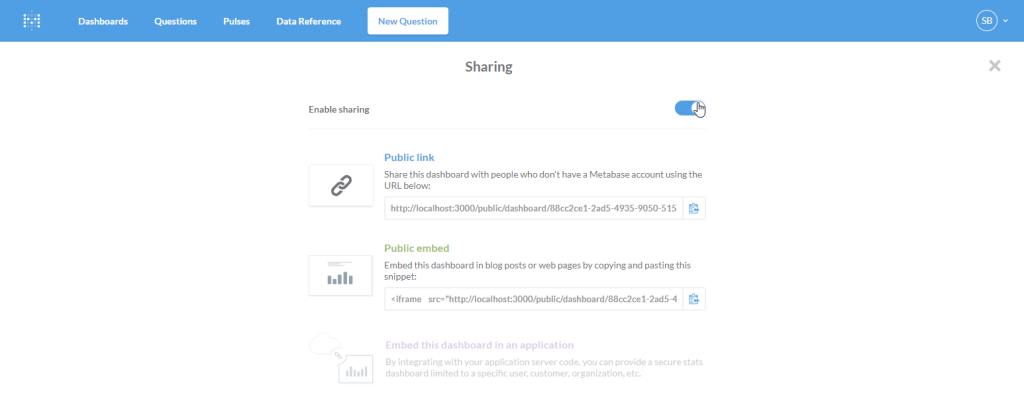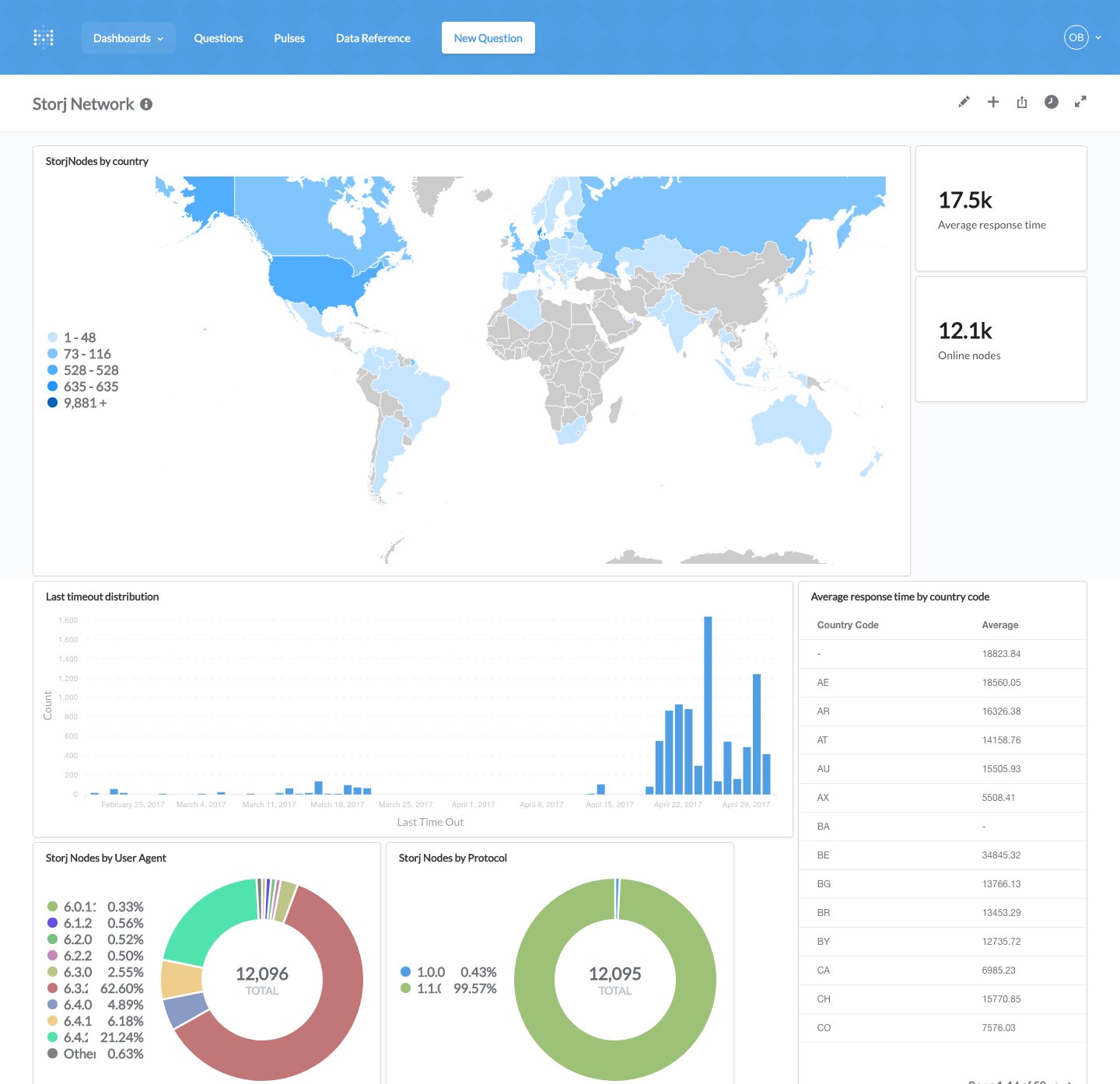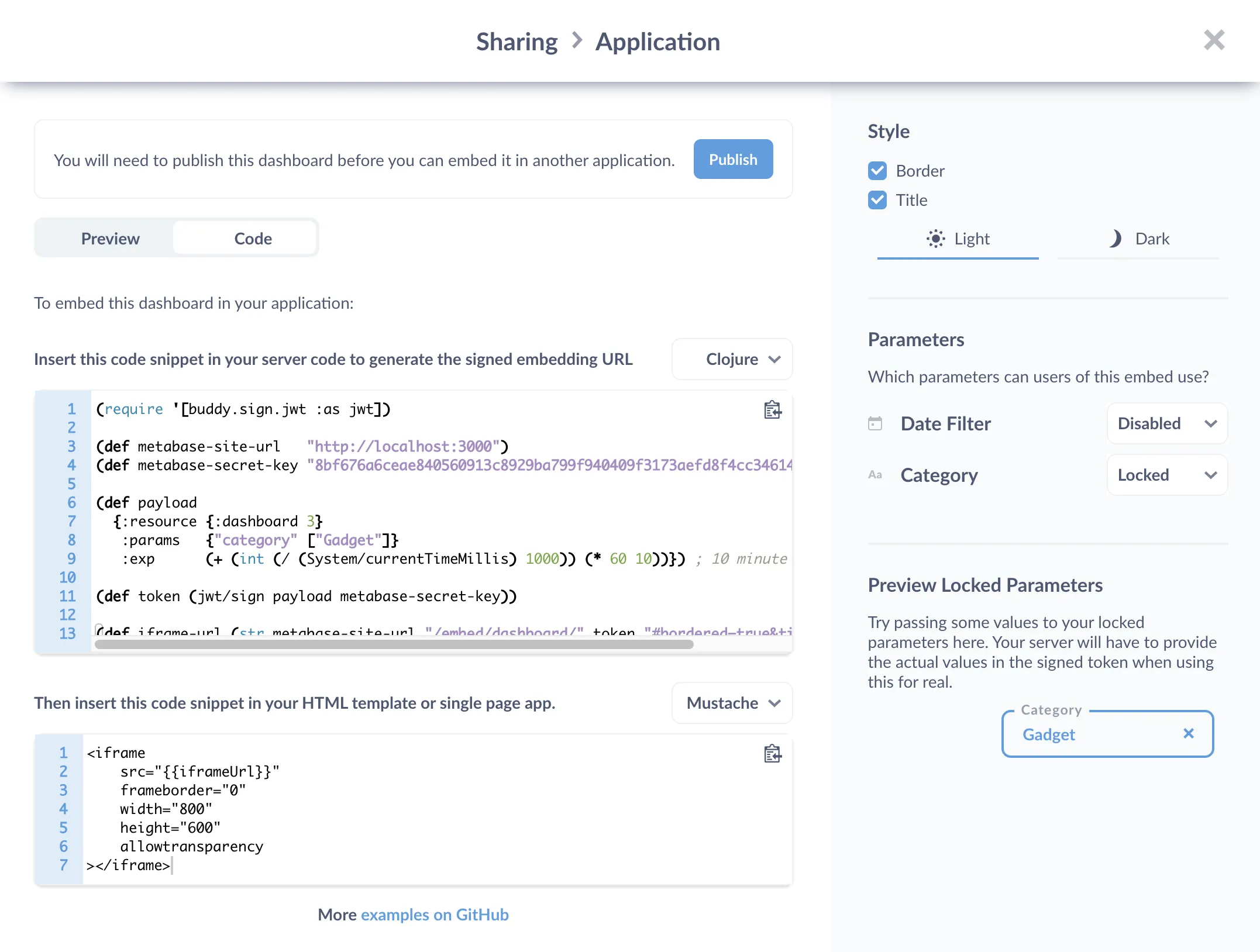Discover Metabase Visualization. Our Metabase visualization layer enables you to quickly generate appealing and insightful charts that are easy to work with and can be shared within your organization or publicly with just two clicks. Our customers can also get their hands on actionable data without forking out on expensive third-party support or waiting for their scarce developers to find the. If your Metabase administrator has enabled public sharing on a saved question or dashboard, you can go to that question or dashboard and click on the sharing icon to find its public links. Public links can be viewed by anyone, even if they don’t have access to Metabase. My Udemy Course: Build a Full-Stack Chrome Extension with NodeJS and MongoDB: https://www.udemy.com/course/build-a-full-stack-chrome-extension-with-nodejs-an. Can dashboard on Superset 拥有访问 examples数据源创建的 dashboard的权限; 3、创建用户. Mainuser: 关联gamma、sqllab与main角色; examplesuser: 关联gamma、sqllab与examples角色; 用不同的用户登录查看每个用户具有的table,以及能查看到的dashboard!! An example of using a public link to share a dashboard, with the Powered by Metabase footer. These public links will include a Powered by Metabase footer, which you can remove with Enterprise embedding. The charts will also have their action menus disabled,.
We know many of you were disappointed by the announcement that Chartio will be going away, and are looking for a new home for your charts and dashboards. So we wanted to provide this brief overview to help you decide if Metabase would be a good replacement for you. The fastest way to get to know Metabase is to download it and try it out, or to start a free Metabase Cloud trial. You can quickly and easily connect to your own data, or just play around the with Sample Dataset included with Metabase.
Before starting: am I in the right place?
Metabase might be the right fit for you if you’re looking for:
- Embedded analytics and customer-facing reporting. You want to embed charts and dashboards in your own application, host a web portal for your customers’ analytics, or create a white-labeled dashboard for clients.
- A way to democratize data access to let anyone explore and create charts and dashboards, even if they don’t know how to write SQL.
- A flexible and open source application that developers and analysts can easily customize and integrate in their workflow.
Free and paid options
Metabase is free and open source. You can host it yourself, or let us handle it on Metabase Cloud. We also have paid tiers with additional features for folks looking either to embed Metabase, or who are looking to manage complex permissions or large numbers of users.
The features
You can also check out our homepage for an overview of our features, or take a Tour of Metabase to get some additional detail.

Supported databases
Amazon Redshift, PostgreSQL, Big Query, Snowflake, MySQL, Mongo, and more: Metabase has a bunch of officially supported databases, as well as a dozen community drivers.
Scalability
Metabase Public Dashboard Sign In
Metabase scales well: check out our articles on Metabase at scale, and making dashboards faster.
Reporting
Metabase makes it simple to connect to your data and start asking questions right away. Here are some details on querying, visualizing, and making dashboards.
Querying data and visualizing results
There are two ways to put together a query in Metabase to create a chart. You can use:
- A graphical query builder that’s simple to pick up, with separate modes for beginners and experts. You can add custom columns and use custom expressions for your filters and aggregations, and even join data, without having to write any SQL.
- A native editor for SQL, complete with variables, and SQL snippets to let you share and reuse code.
Once you have the results you’re looking for, you’ll have more than 15 different visualizations to choose from, including pivot tables, gauges, time series with trend lines, maps, and numbers with percent changes. Check out our visualizations guide for more details.
Dashboards
A dashboard is way more than a collection of charts in Metabase.
- You can create interactive dashboards with drill-through capabilities, customizable click behaviors, and cross filtering.
- Speaking of filters, Metabase lets you add smart filter widgets to your dashboards that allow anyone to explore and modify the SQL-based charts in your dashboard.
- Keep your team in the loop with dashboard subscriptions to schedule reports via email or Slack. In the Enterprise edition, you can even customize filter values for different recipients.
Sharing and embedding
We’ve already mentioned dashboard subscriptions, but here are some other ways to share what you make in Metabase with others.
Sharing
Sharing a question or dashboard is as simple as sending someone a link (check out our Guide to sharing data). Or, you can always export your results to a CSV, XLSX, or JSON file.
Beyond dashboard subscriptions, you can also set up alerts on questions to send updates when a condition is triggered, like when a metric crosses a threshold.

Embedding
You can embed single charts or entire dashboards in your app. The free open source edition will include a “Powered by Metabase” logo at the bottom of your embeds, while the Enterprise tier removes that attribution and allows you to embed the full Metabase application in your app, letting your customers explore the data on their own. Check out our guide on embedding Metabase in your app to deliver multi-tenant, self-service analytics.
Permissions and auditing
Metabase handles permissions using groups, allowing you to control access to individual databases and tables, or to the collections containing your charts and dashboards.
If you need even more granular control over permissions, the Enterprise Edition includes data sandboxes that allow you to customize access to specific rows and columns in your tables. You can take a look at How to scale self-service analytics for an overview.
Lastly, in the Enterprise Edition, the Auditing tool lets you to track queries, downloads, dashboard views, and more, letting you answer the question “who saw what when?”
Support
Direct support
Metabase Cloud and Enterprise customers enjoy support directly from the Metabase team.
Documentation and education
We’ve got you covered here. Metabase is easy to pick up and run with, but it has a lot of depth. We have reference materials in our documentation, and walkthroughs and guides on Learn Metabase.
The Metabase forum
If our docs don’t cover it, check out our discussion forum, which is a treasure trove of tips and problems solved. We even have a few core members of the Metabase team hanging out in there to help the community.
Migrating from Chartio
Check out Chartio’s migration guide to learn how to export your data. As for getting those questions into Metabase, you have a couple of options. You can rebuild your queries individually in Metabase using the graphical query builder, or copy and paste them into the SQL editor. That might take a while, though, so if you’re so inclined you can also use the Metabase API to programmatically create queries in Metabase by importing your exported SQL queries. If you want to prioritize things, you can check out your usage stats in Chartio to find your most-used queries, and migrate those first.

Okay, so this is interesting — what next?
If you’ve made it this far, it’s probably time to spin up your own Metabase and kick the tires. But if you still have questions, feel free to start a chat with us or use our contact form.
v0.39.0.1 / Administration Guide / 12 Public Links
Sharing and embedding dashboards or questions
Sometimes you’ll want to share a dashboard or question you’ve saved with someone that isn’t a part of your organization or company, or someone who doesn’t need access to your full Metabase instance. Metabase lets administrators create public links and simple embeds to let you do just that.
Turning public links on
First things first, you’ll need to go to the Admin Panel and enable public sharing. In the future, you’ll see dashboards and questions you’ve shared listed here, and you’ll be able to revoke any public links that you no longer want to be used.
Enable sharing on your dashboard or saved question
Next, exit the Admin Panel and go to the dashboard or question that you want to share, then click on the Sharing and Embedding icon in the top-right of the screen (it looks like a box with an arrow pointing up). Then click on the toggle to enable public sharing for this dashboard or question.
Copy, paste, and share!
Now just copy and share the public link URL with whomever you please. If you want to embed your dashboard or question in a simple web page or blog post, then copy and paste the iframe snippet to your destination of choice.

Assigning values to filters or hiding them via the URL
This is a bit more advanced, but if you’re embedding a dashboard or question in an iframe and it has one or more filter widgets on it, you can give those filters values and even hide one or more filters by adding some options to the end of the URL. (You could also do this when just sharing a link, but note that if you do that, the person you’re sharing the link with could of course directly edit the URL to change the filters’ values, or to change which filters are hidden or not.)
Here’s an example where we have a dashboard that has a couple filters on it, one of which is called “ID.” We can give this filter a value of 7 and simultaneously prevent the filter widget from showing up by constructing our URL like this:
You don’t have to assign a filter a value, though — if you only want to hide it, so that it isn’t usable in this context, you can do this:
Note that the name of the filter in the URL should be specified in lower case, and with underscores instead of spaces. So if your filter was called “Filter for User ZIP Code,” you’d write:
You can specify multiple filters to hide by separating them with commas, like this:
Metabase Public Dashboard Template
To specify multiple values for filters, though, you’ll need to separate them with ampersands (&), like this:

Metabase Public Dashboard Log
Next: embedding dashboards and charts in other applications
Metabase Public Dashboard Examples
If you’re trying to do more complex, integrated embedding in your own web application, then you can check out the documentation for that feature.
